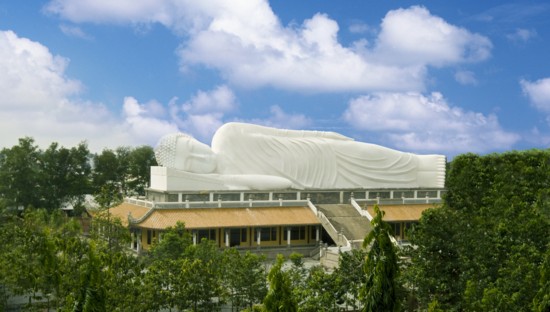The pagoda was constructed in 1741 of the 18th century at a foot of a hill 500 meters from Thu Dau Mot City to the East; however, it was burnt down by the French colony in 1861. By 1868, the pagoda was built on the current location of 1,211 m2. By 2007, the 27-m 7-storey tower was built to reconstruct the Buddhism event of "Tu dong tam" (the four caves of the heart) including Lam Ti Ni Garden (the garden where the Buddha was born), Bo De Dai Trang (the place where the Buddha implements Buddhism), LocUyen Garden (the place where the first Buddhism theory is born), Ta La Song Tho (the place where the Buddha enters nirvana), representing the deepest Buddhism.
In 2008, the large-scale Buddhatower and statue of 22 meters highwas constructed in the land area in front of the pagoda. The ground floor is a range of housing of 64x23m used for schools and librabry. On the top floor is the Buddha in Nirvana Statue lying on 52 meters long and rising 12 meters high. This is the artistic construction of pride and honor of Buddhism in Binh Duong, inaugurated solemnly on March 30, 2010 (the lunar February 15th, 2010) celebrating 1,000 years of Thang Long - Ha Noi.
Although the pagoda has undergone re-construction and innovation, it is one of the unique pagodas to retain the preliminary architecture. The prominent feature of this old pagoda is the value of history, culture, art, architecture, and remains of hundreds of years retained to today. Hoi Khanh Pagoda is considered as the model pagoda of old time in Binh Duong Province.
.jpg)
The pagoda includes four major parts. The frontier hall is the major hall of preaching, constructed by 92 pillars of precious woods. The East and West corridors are arranged in connected parallel architecture patterns that are overlapped just the same as traditional old pagodas of the South. The main hall constructed by beams and pillars, wooden walls, and door curtain includes nearly 100 wooden statues of Arhants and the ten saints sculptured by jackfruit wood and galvanized. The sculpture picture of 18 Arhantsand Bodhisattva, creating artistic works created by excellent sculpture craftmen of the late 19th century including Truong Van Cang, Nguyen Van Ba, Nguyen Van Xu, Sau Nhong, Chinh Tri, etc.
For interior decoration, the statue picture for worshiping is sculptured with sophisticated features including the divider sculptured with 18 Arhans in 1921 and the sculptured pannels telling "four eras" of Buddhism fixed to the two pillars of the main hall. Sophisticate altars were finished in 1925. A wooden imprinting set used for printing Buddhism documents of over 120 years old has been maintained at the pagoda. The giant bell of the pagoda was cast in 1883 and donated by Duong Van Lua as early and strong foundation of Buddhism in the locality.

In 1923-1926, Hoi Khanh Pagoda had been hiding place for patriots who established association of honor with participation of Monk Tu Van, Doctor Nguyen Sinh Sac – the biological father of President Ho Chi Minh, Tu Cuc, and so on to encourage lifestyles of ethics, honor, and love for the people. Despite short-term existence, the association had made great impression.
After August Revolution in 1945, Hoi Khanh Pagoda became a facility of Thu Dau Mot Provincial Buddhist Association of Nation Saving with plenty of devotion and sacrifices. Ever since the resistance war from 1953 to 1983, the pagoda had been a facility of local association of Buddhism. By 1995, the Song Be Provincial Basic Buddhism Study was constructed at the pagoda. Currently, senior monk Thich Hue Thong is managing the pagoda (ever since 1988) as a permanent deputy of local association of Buddhism.
By May 2013, Asian Record Organization officially certified that the lying Buddhism statue of Hoi Khanh Pagoda as the longest lying Buddha in nirvana of Asia. The statue has become a part of religious lives of Vietnamese people in the course of developing Buddhism locally and nationwide.